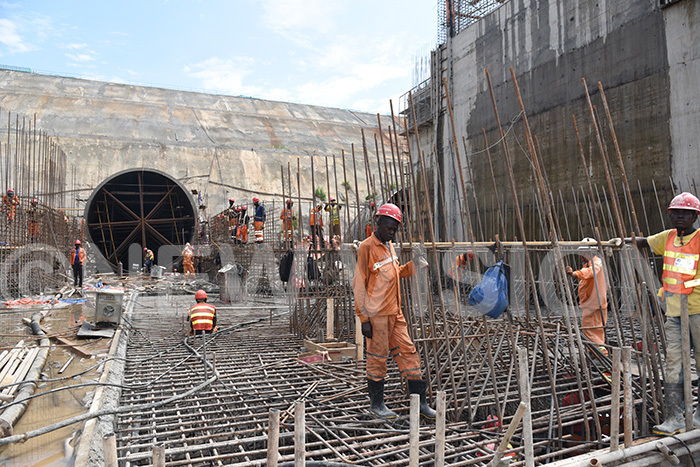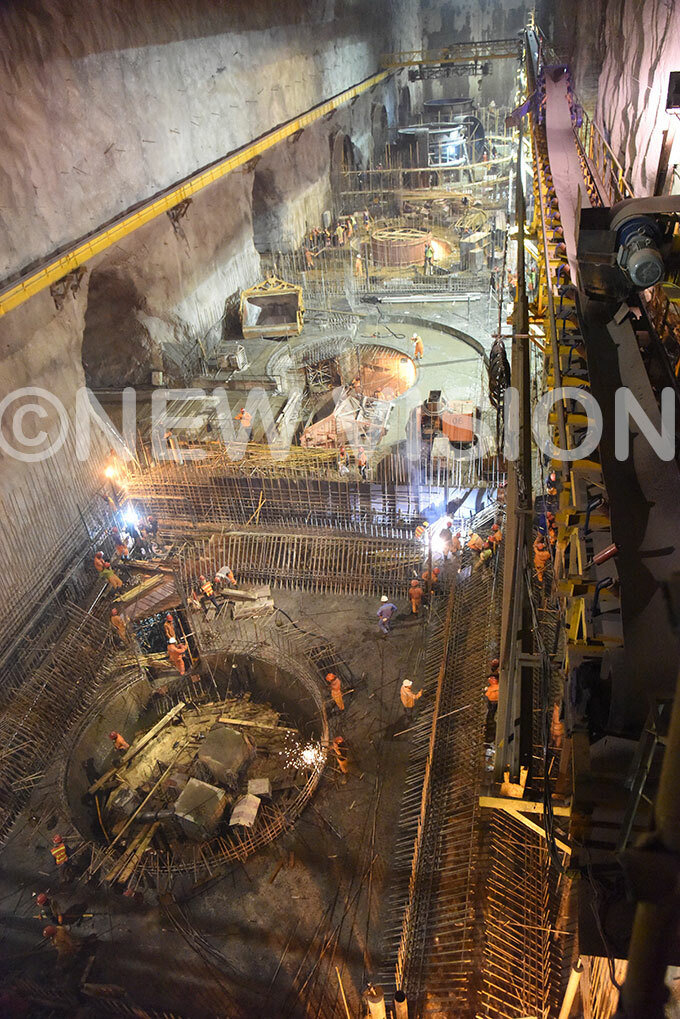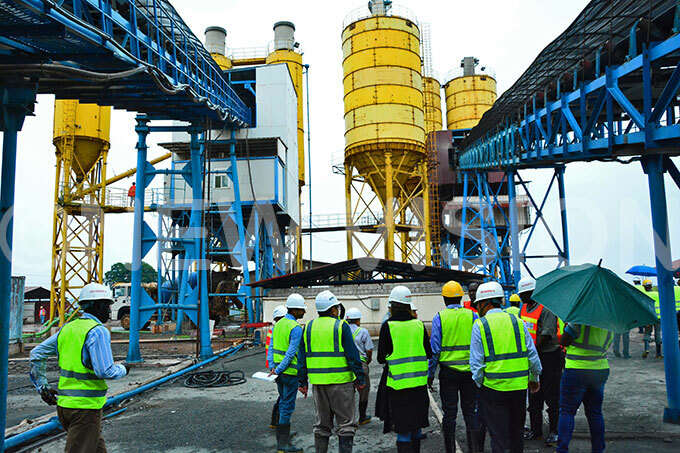How River Nile is powering 10 nations
The plant, which is under construction around River Nile in Kiryandongo district, will be Uganda’s biggest hydropower dam.
RIVER NILE| HYDRO ELECTRICITY
Robert Okullo, 25, has been operating a video library and a photo studio in Arua town for the last five years. His business solely depends on power. But the unremitting power blackouts Arua experienced in the last and early months of 2016 and 2017 respectively hit his business hard.
"I cannot work without power. The power supply here is always erratic, and my business has been suffering," he said.
The long dry spells that hit parts of Uganda between November 2016 and April 2017 left River Nyagaki, the source of water for the 3.5MW hydropower plant, virtually dry. The plant is the only source of power for five districts in West Nile region, including Arua, which are not connected to the national electricity grid.
The plant's generation capacity started falling last November, and the West Nile Rural Electrification Company Limited (WENRECO), a firm that operates the facility, responded by load shedding parts of the region.
"Our businesses have been seriously hit this year, and if we continue to experience the same, some of the businesses will close," Okullo said
By January 2017, the plant was being switched off daily from 12:00am to 7:00am and between 3:00pm and 6:00pm to raise a substantial amount of water for the run-off-the river facility to generate electricity. This went on for several weeks till between March and May when the rains returned. The river flows into Uganda from DRC.
"The period between the last and early months of 2016 and 2017 were terrible. The water levels in the river had never fallen to the level experienced during that period since the plant was switched on in 2012," Norbu Tshering, the WENRECO general manager, said.
While power generation at the plant has now improved as a result of the current rains, there are fears that the facility could be hit again by the dry spells in the coming months. But such fears will probably be no more once the 600MW Karuma hydropower plant comes on stream in December 2018.
The plant, which is under construction around River Nile in Kiryandongo district, will be Uganda's biggest hydropower dam. Once it is up and running, according to the energy ministry, there will be more power to connect to the national grid more areas, including West Nile.

The 183MW Isimba, which is also under construction around River Nile covering parts of Kayunga and Kamuli districts, is also expected to come online in August 2018.
The energy minister, Irene Muloni, said the ministry is currently procuring contractors to build power transmission lines from Uganda to Tanzania, South Sudan and DRC. Currently, Uganda is generating 947MW of power
"Our generation capacity will double the current by the end of 2018. We are looking for contractors to establish the transmission infrastructure to sell power to neighbours," Muloni said. The 83MW Agago-Achwa hydropower dam, which is under construction, is expected to be switched on in October next year.
Uganda will be exporting power to the three countries under a cooperative arrangement of the ten Nile Basin states requiring them to share among themselves the benefits harnessed from the shared River Nile.
And it is not only Uganda that is complying with the collaborative arrangement of the Nile Basin states, which also include, Kenya, Burundi, Tanzania, Rwanda, South Sudan, Sudan, Ethiopia and Egypt.
Tanzania, Rwanda and Burundi are currently building the 80MW plant in Rusumo district (in Rwanda) on River Kagera. The joint project is being funded through a $340m (loan and grants) to the three countries from World Bank. Over $126m has also been secured from African Development Bank to build power transmission lines to the three countries.
The project is the fruit of the collaboration between the Nile Basin states to harness together the benefits of the shared water resource.
"We are bound by one river. We need to collaborate; not only on the Nile, but in all other sectors. Initiatives like Rusumo dam show that there is a lot of hope in collaboration," Sophia Gai, the South Sudanese minister for water resources and irrigation, said.
Ethiopia is currently building the over 6,400MW Grand Ethiopian Renaissance Dam (GERD) around the Blue Nile to generate more power for its nationals and neighbouring countries. The plant is expected to be switched on next year.
According to the Ethiopian minister for water, irrigation and electricity, Seleshi Bekele, the country will supply power from GERD to Sudan, Djibouti, Kenya, South Sudan, Tanzania and Rwanda. Sudan and Djibouti are already receiving 300MW and 100WM respectively from Ethiopia through the 230KV transmission line.
The minister explained that a 500KV transmission line is under construction between Ethiopia and Kenya. The line, he stated, will be extended to Tanzania and Rwanda to export 2000MW of power to the East African countries. Ethiopia has also signed a memorandum of understanding with South Sudan to build a power transmission line to the world's youngest nation.
"The GERD will not produce power for Ethiopia alone. How do we respond to the economic needs of the region if we do not build such an infrastructure? We are integrating the energy system for the region," Bekele said.
The dam, the minister said, should be viewed as "a great economic opportunity" for the region. "Let us see the glass as half full. And there is room for cooperation," he added.
Why collaboration is vital now
The Nile Basin countries are moving to strengthen their collaboration in harnessing the shared resources, mainly River Nile, in the face of the growing population and rising demands for energy as well as food.
It is estimated that the basin's population currently estimated at about 400 million people, will reach one billion by 2050. All the countries in the basin have set themselves ambitious goals such as Vision 2040 for Uganda to transform economies and the people. But they also have to implement the African Union agenda 2063 and pursue the Sustainable Development Goals.
The countries will require huge amounts of water in trying to achieve their goals, and the Nile Basin is their major source. But this will require the countries to deepen cooperation in utilizing and managing the shared resource without endangering lives in other states. Mismanagement of the shared resource can spawn grave social, economic, environmental, security and foreign relations implications. The rising population and energy demand partly explains why Ethiopia is constructing the over 6,400MW GERD on the Blue Nile.
But the project has strained relations between Ethiopia and Egypt, with the latter arguing that it was not consulted, and that the plant is likely to impact the volume of water flowing to the northeast African country, with now about 100 million people.
While River Nile is Egypt's only source of water, Ethiopia is also faced with a 15% annual growth in energy demand, and wants to leverage the Nile to increase power generation and lift people out of poverty in a country of over 100 million people. Sudan has not objected to the building of the GERD, and is optimistic that the facility will produce far-reaching economic benefits for the region. Ethiopia, Egypt and Sudan, in 2015, signed a declaration of principles regarding the Nile, and are currently discussing about the filling and operation of the dam expected to come online next year.
Water volumes
According to the Ugandan ministry of water and environment, the amount of water in Uganda is 69 billion cubic meters. Each cubic meter contains 1000 liters. The 98% of the water in Uganda lies in the Nile Basin.
This also implies that 98% of Uganda's surface area lies in the Nile Basin. The 2% of the country's surface area (Karamoja) is located within the Turkana basin and the water (including the rain) in that area is generated within the (basin).
"It means 98 of (surface, rainfall and ground) water is located in the basin, and it is transboundary. It flows from other countries and leaves Uganda to other countries, including the rain because it goes into lakes and rivers and later flows to other countries," a senior water officer at Uganda's ministry for water and environment, said.
In addition, 70% of renewable water in Uganda comes from the Nile basin upstream countries (where it flows from) such as Burundi, Rwanda and Tanzania.
The transboundary nature of the water in Uganda requires the country to cooperate with the upstream countries to guarantee water security for Ugandans. The same makes it mandatory for the downstream countries (where the water flows to from Uganda through the Nile River) to cooperate with Uganda and other countries in the upstream for their water security.
"Cooperation among the Nile basin states is a must because if you choose to run several power dams on River Nile, the water level in other countries will drop. It means ships cannot dock and the water supply systems will be compromised," Eng. Sowedi Sewagudde, a principal water officer in charge of transboundary water affairs at Uganda's ministry of water and environment, said.
But the policy makers and technocrats in the Nile Basin countries are not just realizing the need for cooperation and harness the benefits of River Nile together now. As population and pressure on the Nile for food and energy services grew, in 1999, the Nile Basin Initiative (NBI) was set up to serve as a platform for sharing information and promote honest discussion as well as collaboration among the Nile Basin states regarding the use of the river. Karuma dam
Karuma dam
The NBI has recorded substantial gains in trying to foster dialogue and collaboration among the nations that share the river, but a few touchy issues regarding the use of the Nile remain. However, there are efforts to resolve the outstanding issues still impeding inclusive dialogue and full collaboration.
For example, Egypt and Sudan suspended their participation in NBI activities in 2010 after six countries out of ten signed Cooperative Framework Agreement (CFA), creating a legal framework for (NBI) and overriding the powers given to Egypt over the Nile by the colonialists.
However, Sudan lifted suspension in 2013, but Egypt has since stuck to its guns. Uganda, Tanzania, Rwanda, Burundi, Kenya and Ethiopia signed the CFA.
But only Rwanda, Tanzania and Ethiopia have ratified the agreement that seeks to replace the 1929 and 1959 colonial treaties which require the countries in the upstream to seek permission from Egypt before undertaking any projects on the transboundary resource.
The amount of water that flows through the Nile is estimated at 83 billion cubic meters annually. Egypt and Sudan, according to the treaties, are entitled to the 55 and 18 billion cubic meters of the annual River Nile yield respectively. The amount of annual River Nile yield is measured at the Aswan high dam located at the border between Sudan and Egypt. The agreements gave 73 billion cubic meters of water to the two countries, and left 10 billion cubic meters to the eight countries. But some of the water in the Nile is lost to evaporation.
Basin forum
The government delegates from the nine Nile Basin countries converged at Kigali Hotel and Conference Centre under the auspices of NBI on October 23 for a three-day conference themed - Investing in the Nile cooperation for a water secure future - to, among others, deepen their cooperation and share the benefits as well as risks associated with utilizing the river waters without endangering the interests of any member state.
But, again, there were no government delegates from Egypt at the conference. And from the beginning of the conference through to the end, the delegates from the nine countries stressed the need for all nations in the Nile Basin to cooperate regarding the utilization of the waters of the river.
The Rwandan minister for environment, Vincent Biruta, said cooperation among the Nile Basin countries is not an option, but a must in ensuring water security for the region.
 A section of Karuma dam that is under construction at Karuma falls along River Nile
A section of Karuma dam that is under construction at Karuma falls along River Nile
He stated that actually cooperation is a less expensive and the only viable solution to the water-related challenges the region is grappling with today, explaining that while people live in defined political boundaries, water knows no such imaginary borders.
"Upstream and downstream water users might have different and conflicting needs, perceptions, interests, claims and cultures. However, we believe that
such diversity should be the best ground and reason for cooperation," Biruta said.
Step in the right direction
Nina Samaani, a lecturer at Mansoura University in Egypt, said the declaration of principles signed by Ethiopia, Sudan and Egypt for DERG, is a step in the right direction.
"Cooperation is a must and it should result into conclusive agreement. We need to move from unilateral actions to joint planning and management," he stated.
Sammaani explained that Egypt opposed the GERD because it was not consulted before its construction, and said all irrigation projects countries intend to set up on the Nile should be discussed first before implementation to promote the spirit of cooperation.
"Currently, Egypt, Sudan and Ethiopia are involved in talks over the first filling of the dam and its operation. We hope there will be an agreement over these critical issues," he added.
The initial cooperative initiatives currently being undertaken by the Nile states reflect the position President Yoweri Museveni presented as the outcome of the first Nile Basin heads of state summit in Entebbe on June 22.
Addressing a press conference at State House, Entebbe, Museveni, who was flanked by the Egyptian president, Abdel Fattah el-Sisi, and Ethiopian Prime Minister, Hailemariam Desalegn, said leaders agreed to harness the river to industrialize the Nile Basin countries.
"We are saying we should work together to transform the Nile Basin countries, do away with backwardness and industrialize the region," he said.
Harnessing together the benefits of a shared resource like River Nile is what has sustained other basins in the world. It is anticipated that joint utilization of the Nile will promote sharing of the river's benefits and its conservation for the current and future generations.